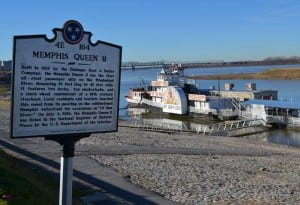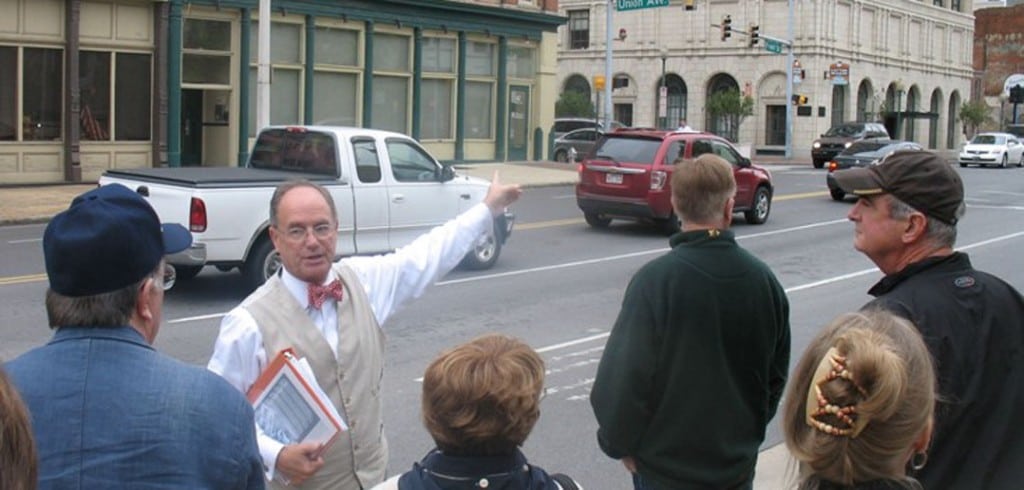I am not an expert on Memphis history. But I know someone who is.
His name is Jimmy Ogle. He is a historian, a walking-tour guide, a consummate volunteer, a historic preservationist and the official Shelby County historian. Ogle is also the community engagement manager for the Memphis Riverfront Development Corporation. As such, he coordinates the landings of the overnight passenger vessels at Beale Street Landing. The last time I heard Ogle talk, I noted some of the amazing things he said about Memphis history:

According to Billboard magazine, more than 1,000 songs have the word “Memphis” in the title or in the lyrics — more than any other city in America. Some of the better known are “Graceland” by Paul Simon, “Memphis” by Jerry Lee Lewis and “Walking in Memphis” by Marc Cohn.
“My favorite is ‘Memphis, Tennessee’ by Chuck Berry,” says Ogle.
Since Hernando de Soto discovered the Mississippi River in or near present-day Memphis in 1541, Memphis is one of the earliest points of discovery in the United States. “I’m not sure if this is appreciated fully,” Ogle says. “To put that in some context, this was 79 years before the Pilgrims landed on Plymouth Rock.
“As I remember grade school, in history class, Plymouth Rock was treated as Genesis 1, Chapter 1!”
The first railroad connecting the Atlantic Ocean to the Mississippi River came through Memphis. It was completed in 1857 and was known as the Memphis & Charleston Railroad.
“At this time, most railroad lines were only about 100 miles long,” Ogle says. “So the idea of a single railroad that went all the way from Memphis to Charleston (S.C.) was huge — it was like going to the moon!”
As part of the opening festivities, water was brought from the Atlantic Ocean and poured into the Mississippi River, and water from the Mississippi River was transported and poured into the Atlantic Ocean. “They called it the ‘Wedding of the Waters,’” says Ogle.
Like the Nashville & Chattanooga Railway, the Memphis & Charleston Railroad was completed just in time for the Civil War. In fact, the Memphis & Charleston had a lot to do with why the Battle of Shiloh was fought in April 1862.
The largest inland naval battle in history occurred on the Mississippi River right in front of downtown Memphis on June 6, 1862. In the 90-minute Battle of Memphis, nine Union gunboats defeated eight Confederate vessels, resulting in the surrender of the city to Union forces.
“The battle was so greatly anticipated by the citizens that more than 5,000 lined the banks of the Mississippi River to watch the battle out in the river,” Ogle says. “It was as if they were spectators at a modern football game.”
Only three years later, the largest maritime disaster in American history occurred when the steamboat Sultana exploded about six miles upstream from Memphis, killing 1,700 people. The vast majority of the casualties were Union soldiers on their way home from Confederate prisoner of war camps. In spite of its significance, the Sultana explosion of April 1865 is overlooked in the history books because it took place when newspapers were dominated by the news of President Abraham Lincoln’s assassination, his funeral procession and the capture of John Wilkes Booth.

Memphis is the site of the nation’s largest remaining original cobblestone landing. Today an estimated 800,000 of the original stones remain along the Mississippi River bank between Beale and Jefferson streets. Many of the people who see the cobblestones appreciate the appearance but may not understand their original purpose. Before the stones were put in (between 1852 and 1891), the mud was so thick along the riverbank that it was hard for people to walk to and from riverboats.
“The mud was so deep that when passengers stepped off a boat and into the mud, they would sink almost knee-deep,” Ogle says. “When they pulled their legs out of the mud, sometimes the mud would suck off a shoe or boot.
“Not a very friendly way to be welcomed to Memphis!”
In the 1990s, an archaeological survey of the landing showed that the most common items found underneath the cobblestones were not arrowheads, bullets or belt buckles. They were shoes and boots!
Between 1880 and 1920, 70 percent of the cotton grown in the United States was harvested within 200 miles of Memphis. Because of that, Memphis was known as the Cotton Capital of the World. At that time, 40 percent of the cotton being used in English cotton mill towns of Manchester and Liverpool came through Memphis. All of this cotton was bought and sold at the Memphis Cotton Exchange. Today, the exchange has been renovated and turned into a wonderful museum about Memphis and the cotton industry.
In the 1880s, Memphis was the mule-trading capital of the world. About 75,000 mules a year were bought and sold in Memphis in that period.
The mule industry reminds us that, when West Tennessee first became agricultural, there were no tractors. “All the trees that were harvested and all the cotton that was planted was done by mule power,” Ogle says. This is why you hear so much about mules in some of those early blues songs.
“To many farmers and sharecroppers, mules were the best friends that they had!”
Memphis contained the largest building in the South starting in 1930 and continuing for several decades. This was the 29-story Sterick building. It remained the largest building in Tennessee until the L&C Tower was built in Nashville in the 1950s. Sadly, the Sterick building has been empty for several decades and is near the top of Tennessee’s historic preservation list of endangered structures.
Memphis contains the first radio station that was programmed entirely for African Americans. The station (WDIA) switched to an entirely black format shortly after it went on the air in 1948. Many music legends got their start by working at the station, including B.B. King and Rufus Thomas. In its early years, not all of its listeners were black; young Elvis Presley used to love listening to WDIA.
Ogle points out that not only did Memphis break the color barrier in radio, but it also broke the gender barrier when the first all-female station (WHER) went on air with eight female deejays!
Memphis is associated with the birth of three different types of music.
The city is considered “Home of the Blues” because W.C. Handy published the first blues song there in 1912.
“Although the blues came out of the Delta, W.C. Handy’s biggest contribution was putting the music to paper for others to be able to read, learn and play at a time when publishing was not readily available,” Ogle says.
Memphis has a claim to be the birthplace of rock and roll because of Sun Records, Elvis Presley, Johnny Cash and such. It is considered the birthplace of soul music because of Stax Records, which produced music by such acts as Isaac Hayes and Otis Redding.
Finally, Ogle points out that Memphis has the largest freestanding letter in the alphabet — on the Hernando de Soto Bridge.
“The bridge arches create a letter ‘M,’ which is 1,740 feet long!” Ogle points out.
To learn more about Jimmy Ogle and his Memphis walking tours, check out his website, www.jimmyogle.com.




